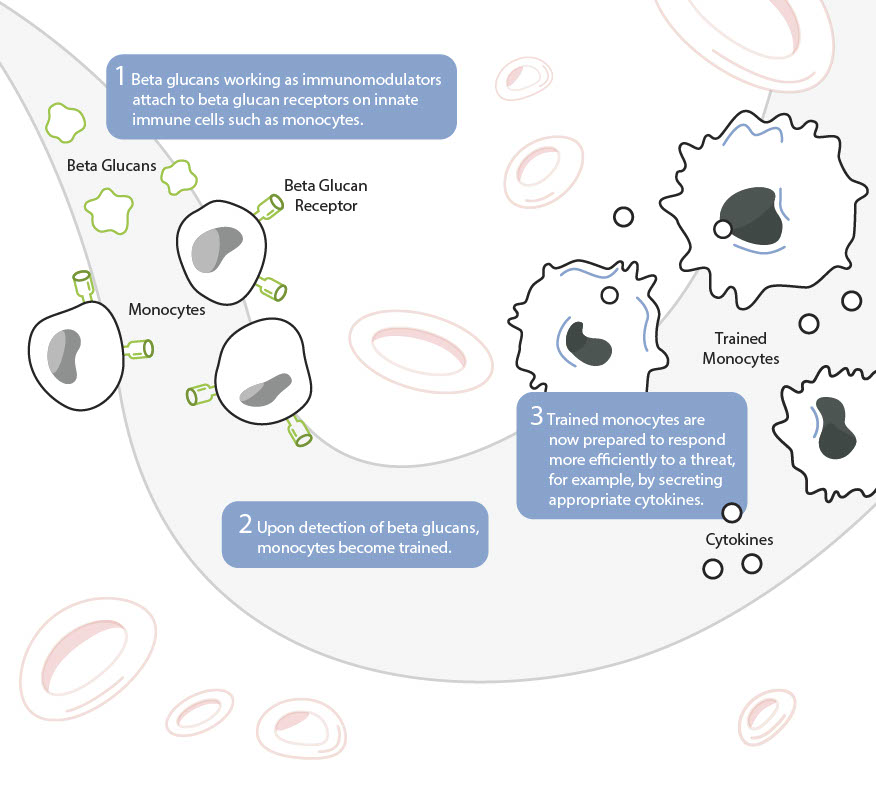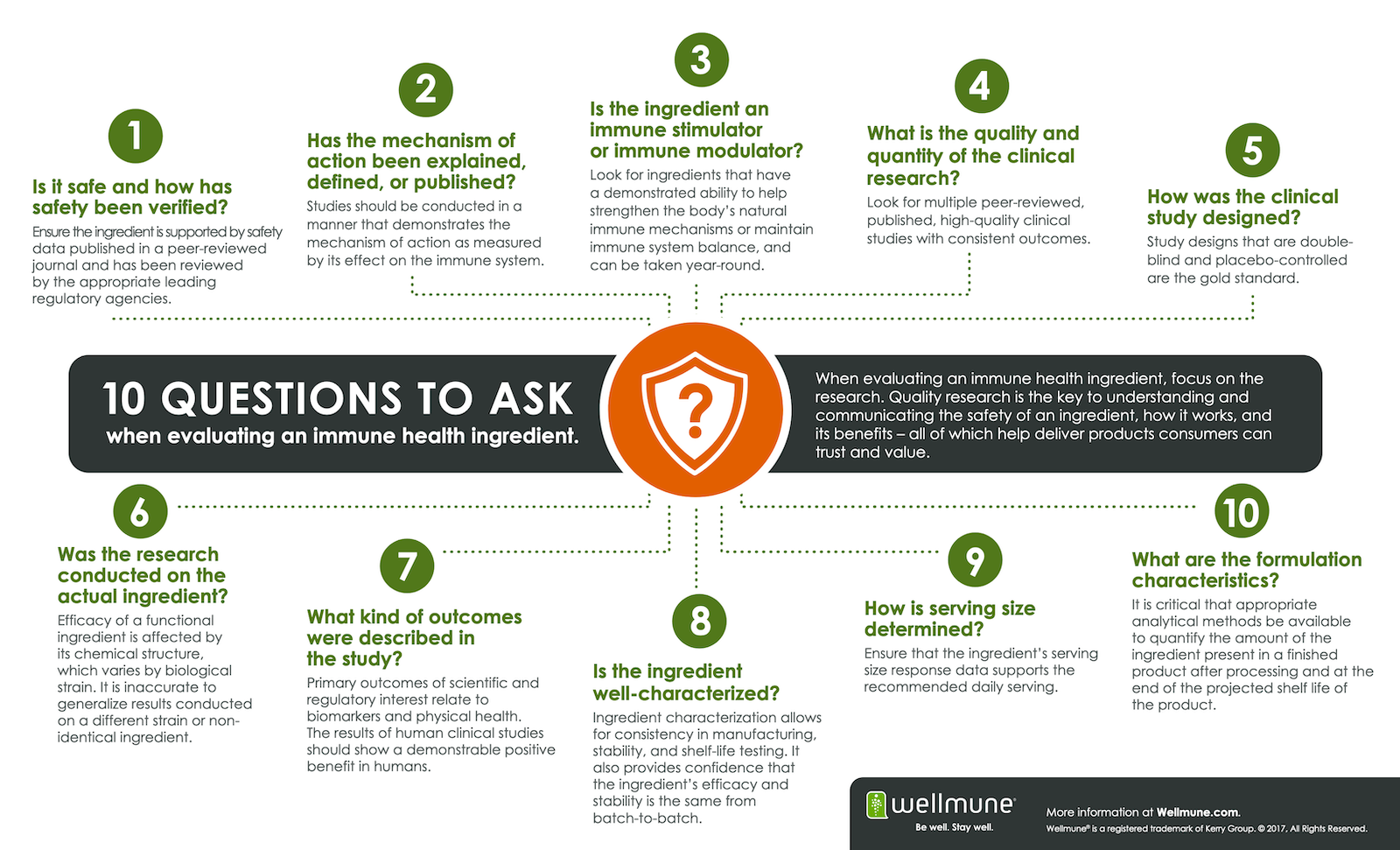Innate immune trainers are a type of immunomodulator. Immunomodulators are defined as substances that can help support immune function by modifying, generally in a beneficial way, the immune system’s response to a threat. Innate immune trainers generally mimic molecules that send a danger signal to the immune system but are not dangerous themselves.
Training the innate immune system refers to what happens when innate immune cells encounter signals from the environment (trainers) that cause them to change how ready they are to go on the attack if a health threat is found in the body. A trained innate immune system is ready to respond more quickly and effectively when the next health challenge is encountered.
Innate immune trainers, some of which can be consumed through the diet, actually train, or prepare, the cells of the innate immune system to respond more effectively to a challenge. This happens in much the same way that strength training in the gym prepares you to handle physical challenges better, such as lifting something heavy.
Innate immune trainers prepare the cells of the innate immune system to more efficiently:
- Make and use energy
- Access and translate the gene “recipes” for defense proteins
- Defend the body against a wide range of health challenges
Recently it has been discovered that a specific type of yeast beta glucan trains the body’s immune cells to react more effectively when a health threat is detected. Through the training process, Wellmune yeast beta glucan positively affects the inflammatory and antimicrobial activities of cells of the innate immune system such as monocytes, macrophages and neutrophils. This training is “remembered” by the cells the next time they come across a health challenge allowing them to respond more efficiently.
Watch this video to see how Wellmune trains the immune system.


Both traditional immune memory and innate immune training are key for a healthy immune response, but they are different. One key difference between innate immune training and the traditional immune memory is how broad the trained response is. In traditional immune memory, the immune system encounters a pathogen (for example, measles) through illness or vaccination and the adaptive immune system creates several types of specific molecules to recognize that pathogen (measles) in the future and block the body from becoming infected. In trained immunity, the innate immune system’s encounter with an trainer adjusts the innate immune response for a more efficient reaction even toward pathogens that look different from the trainer, a key difference from traditional immune memory. Through the training process, several different functions of immune cells are primed for a quicker response including the production of antimicrobial molecules. This more general effect is essential for immune defense because it provides some level of protection from pathogens never encountered before.
The second difference is how long the innate immune training/ traditional immune memory lasts. Traditional immune memory lasts for years, in some cases for a lifetime. The innate immune training effect lasts for a shorter time, generally for weeks up to a couple of months. In this way innate immune training is also like fitness training, when you stop doing the fitness training you lose the fitness training benefit on your body. When the immune system hasn’t encountered the trainer for a period of time the training effect is lost.

No. Not all beta glucans have the same health benefits because they can have different sources. There are multiple sources of beta glucans including yeasts, grains and mushrooms. Beta glucans from each source have different associated health benefits.
Even when considering beta glucans from a similar type of organism such as yeast, the specific source (e.g., strain of yeast) for a beta glucan makes all the difference in terms of safety, mechanism of action, and efficacy. That’s because each type of beta glucan, molecularly speaking, has a different backbone and branching structure that can give it health benefits that are completely different from other types.
What we know is that some beta glucans (but not all), mostly those from yeast, are shown to support immune health. Yeast-derived beta glucans usually originate from either baker’s yeast or brewer’s yeast (Saccharomyces cerevisiae). Even though both baker’s yeast and brewer’s yeast produce beta 1,3/1,6 glucans, the source matters for the shape of the molecule and shape is critical for providing health benefits. Beta glucans extracted from the cell walls of baker’s yeast exhibit a different molecular pattern from that of brewer’s yeast, which can influence the immune-modulating abilities of the beta glucan.
Although multiple types of biological activities are attributed to yeast beta glucans, not all beta glucans affect immune activity. The health benefits associated with a yeast beta glucans depend on the chemical structure of the molecule. In the peer-reviewed scientific journal Food Chemistry, differences in purity, amount and length of the branches between sample of yeast beta glucans was studied. The proprietary baker’s yeast beta glucan, Wellmune®, was found to have a unique structure, with a different branching and linkage pattern from the other samples. This research clearly demonstrates that yeast beta glucans from different commercial sources are notably different from each other structurally. The same study concluded that such differences are largely a result of both the source or strain of yeast and the methods used to isolate and purify it.
Certain beta glucans (beta 1,3 and beta 1,4 glucan) derived from cereal grains, predominantly oats, have been found useful for managing cholesterol levels—specifically, LDL, or bad, cholesterol. One study found that 6 grams/day of oat beta glucan lowered total and LDL cholesterol levels in subjects with elevated cholesterol by 9 percent after four weeks. Another study found that using beta glucans derived from barley rather than oats had no real effect on cholesterol, though a high molecular weight–concentrated barley beta glucan was beneficial in helping some of the study’s 90 subjects lose weight.
So, while beta glucans from oats have not been shown to provide immune health benefits, studies have confirmed that certain oat beta glucans can help lower cholesterol levels and provide heart health benefits.
Mushroom beta glucans are found in the cell walls of both the fruiting body and the mycelium of the mushroom. In terms of health benefit research, the findings related to immune responses have been mixed. People tend to mistakenly lump all mushroom species together as one homogeneous group. However, there are an estimated 10,000 species known in North America alone, and many believe there are thousands that remain undiscovered. Because of the sheer number of mushrooms species it is difficult to generalize about their benefits, though researchers have honed in on a few different types of mushrooms that may have bioactivity. However, even when reviewing the data on only one species of mushroom it is clear that some studies show efficacy, and others not so much.
For example, one study tested beta glucans derived from the common edible oyster mushroom with 175 children and observed fewer children experiencing upper respiratory tract infection symptoms compared to the control group. But another study that used beta glucan from shiitake mushrooms found no significant difference between treatment and control groups.
Given the vast number of mushroom types and even greater number of variations in mushroom beta glucan chemical structure that likely impacts their efficacy and associated health benefits, further clinical research is needed to fully understand how each type of mushroom beta glucan works. Ultimately, although some mushroom beta glucans may have immune health benefits, research shows that their potency is lower than that of the well-studied baker’s yeast beta glucan postbiotic Wellmune.
When evaluating a baker’s yeast beta glucan for its benefits, and its capacity to support immune health, look for clinical research that supports the ingredient’s mechanism of action and provides results that demonstrate its safety and effectiveness. The research must have been conducted with the specific ingredient being evaluated because the process of extraction and source make a difference in efficacy. When sourcing a baker’s yeast beta glucan for immunity-positioned foods, beverages, and supplements, the research behind it is what will bring quality to a product. Multiple high-quality clinical studies published in peer-reviewed journals that report consistent outcomes on that particular baker’s yeast beta glucan are the gold standard.
Yes. Wellmune is supported by numerous biomarker, mechanism-of-action, and clinical efficacy research studies published in peer-reviewed journals. The published research studies on Wellmune demonstrate its ability to support key immune functions, improve overall physical health, maintain healthy energy levels, provide immune support as we age, and help keep us healthy during times of stress. It has GRAS status from the US FDA indicating its safety and applicability for a wide range of populations.
A few things that play a key role in ensuring that a beta glucan is of high quality are an understanding of the stability profile and how manufacturing processes impact the beta glucan’s biological activity. It is also important to understand how efficacy is measured and defined.
The manufacturing or processing methods used to extract the beta glucans can impact their structure. If the beta glucan’s structure is damaged or altered during the manufacturing process, there could be a loss of efficacy or measurable immune health benefits for the consumer.
Because not all beta glucan sources have been linked to immune health benefits, knowledge of strain sources and clinical research are essential to understanding their benefits. Clinical research that supports a beta glucan’s biological activity must be specific to the manufactured ingredient that will be used in a final product. This is the only way to ensure efficacy.
We often see functional ingredients that either lack serving size research to determine optimum serving sizes or finished products containing only a small fraction of the ingredient’s efficacious serving as demonstrated in clinical studies. A recommended daily serving should deliver benefits consistent with the clinically-studied amount in order to provide the benefits described in the clinical studies.
Quality research is the key to understanding and communicating the safety of an ingredient, how it works, and its benefits – all of which help deliver products consumers can trust and value.
Here are 10 questions to ask when evaluating an immune health ingredient.

